#hieromartyr
Photo

Today we celebrate the Hieromartyr Haralambos of Magnesia. Saint Haralambos lived as a priest during the persecution of Christians under the rule of military commander Lucius. Because of his fervent preaching and mass conversions, he was brought before the commander and ordered to offer sacrifice to the idols. Boldly refusing, Saint Haralambos was subjected to fierce tortures, despite being already 113 years old. They lacerated his body with iron hooks and tore the flesh from his bones. The holy one said to his torturers, "I thank you, brethren, that you have restored my spirit, which longs to pass over to a new and everlasting life!" Seeing the holy elder's endurance and pure love for them, the two tortures openly confessed Christ, along with three women bystanders, who all received a martyr's crown for their confession. The enraged Lucius took the torture devices himself and began tormenting the Saint, however his arms were sliced off as if by a sword and his head turned around until he was facing backwards. Lucius begged the Saint to heal him, and Haralambos did so. The governor fell at the feet of the Saint, begging for forgiveness and asked to be baptised. These events were reported to Emperor Severus who summoned the Saint before him. He ordered that his long neared be twisted into a rope around his neck and that he be dragged along the dirt. They also drive a large nail into him and tortured him with fire. God, however, protected his Saint and kept him unharmed. Many miracles occurred through Saint Haralambos including the resurrection of a young man, the exorcism of a demoniac, and many others. Multitudes turned to Christ and because of this, Saint Haralambos was subjected to even more tortures and was finally beheaded. His sacred skull is kept in Greece and is the source of countless miracles. He is the Patron Saint of many cities and villages throughout the world. May he intercede for us always + #saint #haralambos #hieromartyr #martyr #priest #christian #preaching #gospel #christ #jesus #jesuschrist #miracle #baptism #convert #repent #faith #love #greatmartyr #haralampos #orthodox #saintoftheday (at ısparta) https://www.instagram.com/p/CodSBdOBN8M/?igshid=NGJjMDIxMWI=
#saint#haralambos#hieromartyr#martyr#priest#christian#preaching#gospel#christ#jesus#jesuschrist#miracle#baptism#convert#repent#faith#love#greatmartyr#haralampos#orthodox#saintoftheday
16 notes
·
View notes
Text
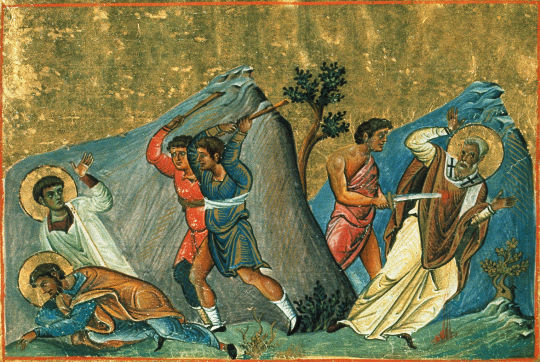
Hieromartyr Mίlos (or Milēs) the Wonderworker, and two disciples
Commemorated on November 10
O God of our Fathers, always act with kindness towards us; take not Your mercy from us, but guide our lives in peace through the prayers of the hieromartyrs Milles, Euores, and Seboes.
The Persian Martyr Mίlos was once a General. Later, he was chosen as the Bishop of Telepolis (Susa, or Shushan in Syriac), where the Prophet Daniel saw visions. Because of his devout ascetical life, Saint Mίlos received from God the gifts of prophecy and healing. He was ordained by Bishop Bēthlapát of Geddēgoupólis. When the pagans expelled him from the city of Susa, his episcopal See, he fled to Jerusalem. From there, he went to Alexandria, where he met Saint Anthony the Great (January 17).
After two years the Hierarch returned to Persia, where he and his disciples were arrested by the ruler Basiliskos. Saint Mίlos was put to death by the sword. His disciples Ebórēs, Papas, and the Deacon Senóei (or Sebórēs), were killed with wooden clubs and stones. Thus, they all received the immortal crown of martyrdom in the year 341.
The Church glorifies you as teachers of virtue and adornments of hierarchs, singing: “By your intercessions for those who lovingly honor you, grant progress in virtue, and deliverance from temptations.”
[Source]
2 notes
·
View notes
Text
«I am not afraid of anyone or anything. I am at all times prepared to give my life for Christ’s Church & for the Orthodox faith.»

O ye saint whom we have remembered here, forgive the poverty of these words, that praises may be written more fitting for you.
O all-hymned Mother: even though thy great Church of the Caves hath been demolished by the wicked, wherein the hieromartyr Vladimir, when the day of his murder drew nigh, read the Akathist hymn with great compunction, praying to thee, yet thy mercy for repentant people doth not fail forever. Rejoice, O joyous one, who in thy dormition hath not forsaken us!
9 notes
·
View notes
Text
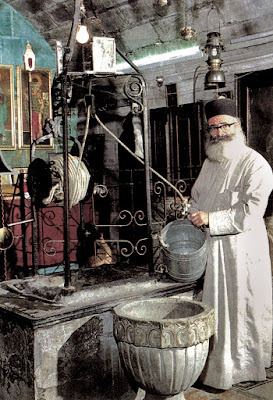
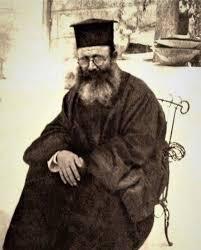
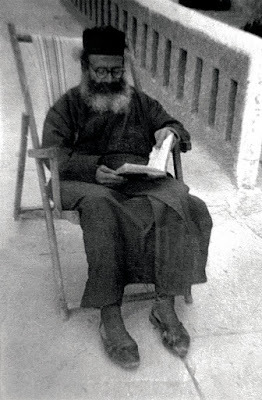
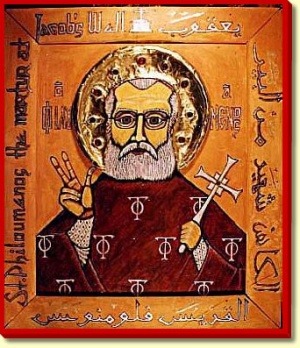
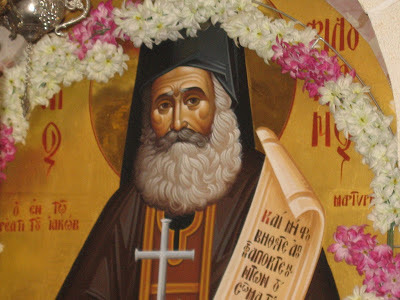


Holy hieromartyr Philoumenos of Cyprus (1913-1979) †
"Saint Philoumenos was born on October 15th, 1913 in the parish
of Saint Savvas in Nicosia, along with his twin brother Archimandrite Elpidios.
At the age of 14, the two brothers left for the ancient Monastery of Stavrovouni, and stayed there for five years. Later, the saint joined the monastic brotherhood of the holy sepulchre. In 1979, he was appointed guardian of the monastery of Saint Jacob´s Well.
In the afternoon of November 29th, 1979 - “strangers”, according to the police report, trespassed on the premises of Jacob’s Well. They found the opportunity to hide and remain in the monastery after 4:00 p.m. when the guard had already left. Possibly while the Saint was performing vespers, they attacked him with an axe, and having fiercely abused him, they killed him.
The body of the Saint was handed over to the Orthodox 6 days after his massacre, but retained its flexibility and was buried in the cemetery of Mount Zion.
૮ ◞ ﻌ ◟ ა 3 things were most remarkable about the blessed martyr. The first might have been partly from nature: this was his soft sweet voice. The second was a meticulous fidelity to small things, but specifically to the Divine Service. Third, and as unobtrusive, almost secret, was his humility.
૮ ◞ ﻌ ◟ ა St Philoumenos however only knew his monastic cell and his reading. He studied ecclesiastical books
After four years his body was exhumed. It was found to be substantially incorrupt and had the smell of a beautiful scent. His memory is honored on November 29. May his soul rest in peace.
( x x x x x) actually theres other version abt his death but idk its kinda weird t me but im sharing it just in case x
10 notes
·
View notes
Text
Saint Hippolytus of Rome

The hieromartyr Hippolytus of Rome was a priest and an ecclesiastical writer of the third century. He is considered to have been antipope of the Church of Rome from about 217 to 235. He was among the most important Christian theologians of the third century, and a saint. His feast day is January 30.
T
Life
The early life of Hippolytus is unknown. He was born about the year 170 and lived in Rome when young. Greek was his native tongue. He is believed to have been a disciple of Irenaeus of Lyons and to have met Origen. From the details of his work, Philosophoumena Hippolytus apparently was in Rome during the time Victor was the bishop of Rome. At the beginning of the third century he was a priest noted for his learning, eloquence, zeal, and moral earnestness. He was also noted to be a bishop of an unspecified city by Eusebius of Caesarea and Jerome and by the poet Prudentius as bishop of Portus, a port for Rome.
The Philosophoumena, that is a part of his larger work "Refutation of All Heresies", shows that he dissented from the compassionate views of Bps. Zephyrinus, whom he considered to be a weak man "unskilled the church's rule", and Callistus I of Rome concerning the reception of backsliders and heretics who had repented. In the "Refutation of All Heresies" Hippolytus set out to refute the doctrines of the Gnostics and condemn heretics by showing that their views were taken from pagan philosophy and oriental theosophy.
Hippolytus also came into conflict with the opinions of the bishops of Rome on christological issues of the day to such an extant that came to allow himself to be elected a rival bishop of Rome, the first antipope
Under the persecutions of emperor Maximinus Thrax Hippolytus was exiled to Sardinia in 235 where he died, reportedly a martyr. His body was returned to Rome and interred in a cemetery on the Via Tiburtina. By about 255, he was considered a martyred priest by the Church, indicating that he had been reconciled with the Church and not considered a schismatic.
Taken from Orthodox Wiki
#eastern orthodox#orthodox#byzantine#orthodoxy#eastern catholic#christianity#icon#iconography#byzantine icon#christian iconography#Hippolytus Of Rome#St. Hippolytus of Rome#Saint Hippolytus of Rome#Catholic Saint#Orthodox Saint#Greek Orthodox#Russian Orthodox#Roman Catholic#Catholic Icon#Church Father#Eastern Orthodox Church#Russian orthodox icon#great saint#Orthodox Church#early church#patristic#Hippolytus#Orthodox iconography#Eastern orthodox icon#Eastern Orthodox iconography
9 notes
·
View notes
Text

+++🙏🏻God Bless🕊️+++
Hieromartyr Antipas of Pergamon, Bishop
MEMORIAL DAY APRILL 24
You stopped the idolatrous seduction, Antipas, and corrected the devil's power, boldly confessed Christ before the God-worshippers. Therefore, settling in heaven with the Angelic ranks and offering a song of praise to the Lord of all, you also offer prayerful thanksgiving for us, granting the grace of healing. Therefore, we honor you, Holy Martyr Antipas, pray to Christ God for the salvation of our souls.
💫International Orthodox Art Corporation Andcross
May the blessing of the Lord be upon you!
#orthodox church#orthodox icon#orthodoxia#orthodox christmas#russian orthodox#jesus#iconofaday#orthodox#greek orthodox#orthodox christian
3 notes
·
View notes
Text
Saints&Reading: Thursday, March 7, 2024
february 23_march 7
HIEROMARTYR POLYCARP, BISHOP OF SMYRNA (167)
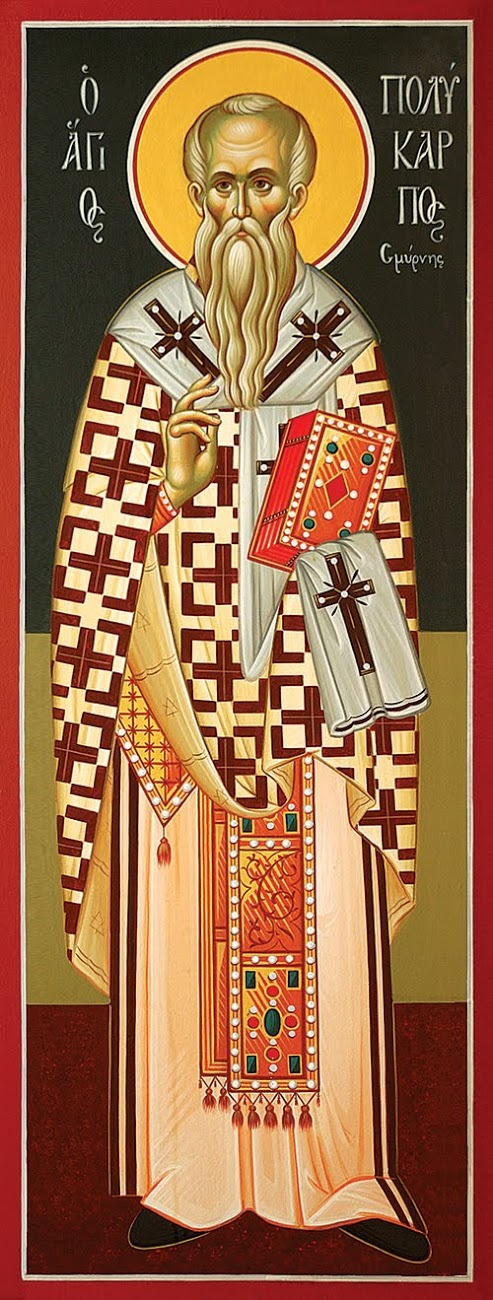
Saint Polycarp, Bishop of Smyrna, who was “fruitful in every good work” (Col. 1:10), was born in the first century, and lived in Smyrna in Asia Minor. He was orphaned at an early age, but at the direction of an angel, he was raised by the pious widow Kallista. After the death of his adoptive mother, Polycarp gave away his possessions and began to lead a chaste life, caring for the sick and the infirm. He was very fond of and close to Saint Bucolus, Bishop of Smyrna (February 6). He ordained Polycarp as deacon, entrusting to him to preach the Word of God in church. He also ordained him to the holy priesthood.
The holy Apostle John the Theologian was still alive at this time. Saint Polycarp was especially close to Saint John, and sometimes accompanied him on his apostolic journeys.
Shortly before his death, Saint Bucolus expressed his wish that Polycarp be made Bishop of Smyrna. When Saint Polycarp was consecrated as a bishop, the Lord Jesus Christ appeared to him. Saint Polycarp guided his flock with apostolic zeal, and he was also greatly loved by the clergy. Saint Ignatius the God-Bearer of Antioch (December 20) also had a high regard for him. Setting out for Rome where execution awaited him, he wrote to Saint Polycarp, “This age is in need of you if it is to reach God, just as pilots need winds, and as a storm-tossed sailor needs a port.”
The emperor Marcus Aurelius (161-180) came to the Roman throne and started up a most fierce persecution against Christians. The pagans demanded that the judge search for Saint Polycarp, “the father of all the Christians” and “the seducer of all Asia.”
During this time Saint Polycarp, at the persistent urging of his flock, stayed in a small village not far from Smyrna. When the soldiers came for him, he went out to them and invited them in to eat. He asked for time to pray, in order to prepare himself for martyrdom. His suffering and death are recorded in the “Epistle of the Christians of the Church of Smyrna to the Other Churches,” one of the most ancient memorials of Christian literature.
Having been brought to trial, Saint Polycarp firmly confessed his faith in Christ, and was condemned to be burned alive. The executioners wanted to nail him to a post, but he declared that God would give him the strength to endure the flames, so they could merely tie him with ropes. The flames encircled the saint but did not touch him, coming together over his head in the shape of a vault. Seeing that the fire did him no harm, the pagans stabbed him with a dagger. So much blood flowed from this wound that it extinguished the flames. The body of the hieromartyr Polycarp was then cremated. The Christians of Smyrna reverently gathered up what remained of his holy relics, and each year they celebrated the day of his martyrdom.
A story has been preserved about Saint Polycarp by his disciple, Saint Irenaeus of Lyons, which Eusebius cites in his ECCLESIASTICAL HISTORY (V, 20):
“I was still very young when I saw you in Asia Minor at Polycarp’s,” writes Saint Irenaeus to his friend Florinus, “but I would still be able to point out the place where Blessed Polycarp sat and conversed, and be able to depict his walk, his mannerisms in life, his outward appearance, his speaking to people, his companionable wandering with John, and how he himself related, together with other eyewitnesses of the Lord, those things that he remembered from the words of others. He also told what he heard from them about the Lord, His teachings and miracles....
“Through the mercy of God to me, I then already listened attentively to Polycarp and wrote down his words, not on tablets, but in the depths of my heart. Therefore, I am able to bear witness before God, that if this blessed and apostolic Elder heard something similar to your fallacy, he would immediately stop up his ears and express his indignation with his usual phrase: ‘Good God! That Thou hast permitted me to be alive at such a time!’”
During his life the holy bishop wrote several Epistles to the flock and letters to various individuals. The only one that has survived to the present day is his Epistle to the Philippians which, Saint Jerome testifies, was read in the churches of Asia Minor at divine services. It was written by the saint in response to the request of the Philippians to send them some letters of the hieromartyr Ignatius (December 20) which Saint Polycarp had in his possession.
The composer H.I.F. Bibier (1644-1704) has written a Sonata “Scti Polycarpi” for eight trumpets in honor of the holy martyr.
THE MONK ALEXANDER, FOUNDER OF THE "UNCEASING VIGILANCE" MONASTERY (430)

Saint Alexander, Founder of the Monastery of the “Unsleeping Ones,” was born in Asia and received his education at Constantinople. He spent some time in military service but, sensing a call to other service, he left the world and accepted monastic tonsure in one of the Syrian wilderness monasteries near Antioch, under the guidance of igumen Elias. He spent four years in strict obedience and monastic effort, after which he received from the igumen blessing to dwell in the desert. Going into the wilderness, the monk took with him nothing from the monastery, except the Gospel. The monk then struggled in the desert for seven years. Afterwards, the Lord summoned him to preach to pagans.
The saint converted to Christ the local city ruler named Rabul, who afterwards was consecrated a bishop and for 30 years occupied the bishop’s cathedra of the city of Edessa. Together with Rabul all the local inhabitants accepted Baptism, and before receiving the sacrament they burned their idols in the city square. Having confirmed the newly-converted in the Faith, Saint Alexander again went into the desert, where by chance he came upon a cave of robbers. Unafraid of the danger that threatened him, he preached the Gospel to them and urged them to repent. In fact, all the robbers did repent. They accepted holy Baptism, and they transformed their cave into a monastery, where they dwelt in prayer and penitence. Saint Alexander appointed an igumen for them, gave them a monastic rule, and he himself resettled still farther in the desert.
For several years he lived in complete solitude. But even there lovers of solitude began to flock to the monk. A monastery emerged, numbering 400 monks. Desiring at this monastery to establish uninterrupted praise to the Lord, the monk prayed for three years, that the Creator would reveal to him His will, and having then received the revelation, he initiated at the monastery the following order: all the monks were divided into 24 watches of prayer. Changing shifts each hour, day and night they sang in two choirs the Psalms of David, interrupting this only for the times of the divine services. The monastery received the name “ the Unsleeping Ones,” because the monks sang praise to God throughout the day and night.
Saint Alexander guided the monastery on the Euphrates for twelve years. Afterwards, leaving one of his disciples, the experienced Elder Trophimus as its igumen, he set out with some chosen brethren through the cities bordering on Persia, preaching the Gospel among the pagans. After this missionary journeying, Saint Alexander lived with his monks for a certain while at Antioch. There he built a church for the city-dwellers, and a home for the sick and homeless with the money that charitable Antiochians put at his disposal. However, through the intrigues of the jealous, Saint Alexander was compelled to move to Constantinople.
Here he founded a new monastery, in which he also initiated a monastic rule of “unceasing vigilance.” Saint Alexander and his monks suffered at Constantinople under the Nestorian heretics, enduring beatings and imprisonment. After this, when the storm of unrest abated, Saint Alexander spent the last days of his life at the Constantinople monastery he founded. He died in extreme old age in about the year 430, after 50 years of incessant monastic effort. He is also commemorated on February 23.
Source: Orthodox Church in America_OCA


1 JOHN 4:20-5:21
20 If someone says, "I love God," and hates his brother, he is a liar; for he who does not love his brother whom he has seen, how can he love God whom he has not seen? 21 And this commandment we have from Him: that he who loves God must love his brother also.
1 Whoever believes that Jesus is the Christ is born of God, and everyone who loves Him who begot also loves him who is begotten of Him. 2 By this we know that we love the children of God, when we love God and keep His commandments. 3 For this is the love of God, that we keep His commandments. And His commandments are not burdensome. 4 For whatever is born of God overcomes the world. And this is the victory that has overcome the world-our faith. 5 Who is he who overcomes the world, but he who believes that Jesus is the Son of God? 6 This is He who came by water and blood-Jesus Christ; not only by water, but by water and blood. And it is the Spirit who bears witness, because the Spirit is truth. 7 For there are three that bear witness in heaven: the Father, the Word, and the Holy Spirit; and these three are one. 8 And there are three that bear witness on earth: the Spirit, the water, and the blood; and these three agree as one. 9 If we receive the witness of men, the witness of God is greater; for this is the witness of God which He has testified of His Son. 10 He who believes in the Son of God has the witness in himself; he who does not believe God has made Him a liar, because he has not believed the testimony that God has given of His Son. 11 And this is the testimony: that God has given us eternal life, and this life is in His Son. 12 He who has the Son has life; he who does not have the Son of God does not have life. 13 These things I have written to you who believe in the name of the Son of God, that you may know that you have eternal life, and that you may continue to believe in the name of the Son of God. 14 Now this is the confidence that we have in Him, that if we ask anything according to His will, He hears us. 15 And if we know that He hears us, whatever we ask, we know that we have the petitions that we have asked of Him. 16 If anyone sees his brother sinning a sin which does not lead to death, he will ask, and He will give him life for those who commit sin not leading to death. There is sin leading to death. I do not say that he should pray about that. 17 All unrighteousness is sin, and there is sin not leading to death. 18 We know that whoever is born of God does not sin; but he who has been born of God keeps himself, and the wicked one does not touch him. 19 We know that we are of God, and the whole world lies under the sway of the wicked one. 20 And we know that the Son of God has come and has given us an understanding, that we may know Him who is true; and we are in Him who is true, in His Son Jesus Christ. This is the true God and eternal life. 21 Little children, keep yourselves from idols. Amen.
MARK 15:1-15
1 Immediately, in the morning, the chief priests held a consultation with the elders and scribes and the whole council; and they bound Jesus, led Him away, and delivered Him to Pilate. 2 Then Pilate asked Him, "Are You the King of the Jews?" He answered and said to him, "It is as you say." 3 And the chief priests accused Him of many things, but He answered nothing. 4 Then Pilate asked Him again, saying, "Do You answer nothing? See how many things they testify against You!" 5 But Jesus still answered nothing, so that Pilate marveled. 6 Now at the feast he was accustomed to releasing one prisoner to them, whomever they requested. 7 And there was one named Barabbas, who was chained with his fellow rebels; they had committed murder in the rebellion. 8 Then the multitude, crying aloud, began to ask him to do just as he had always done for them. 9 But Pilate answered them, saying, "Do you want me to release to you the King of the Jews?" 10 For he knew that the chief priests had handed Him over because of envy. 11 But the chief priests stirred up the crowd, so that he should rather release Barabbas to them. 12
Pilate answered and said to them again, "What then do you want me to do with Him whom you call the King of the Jews?" 13 So they cried out again, "Crucify Him!" 14 Then Pilate said to them, "Why, what evil has He done?" But they cried out all the more, "Crucify Him!" 15 So Pilate, wanting to gratify the crowd, released Barabbas to them; and he delivered Jesus, after he had scourged Him, to be crucified.
#orthodoxy#orthodoxchristianity#easternorthodoxchurch#originofchristianity#spirituality#holyscriptures#gospel#wisdom#bible#saints
2 notes
·
View notes
Text
Customary Saint Titles
of the Eastern Orthodox Church
Theologian: has classical meaning but only three saints have been given the appellation Theologian: John the Theologian, Gregory the Theologian and Symeon the New Theologian
Confessor: one who has suffered for the faith but not martyred outright
Enlightener: the saint who first brought the faith to a people or region or who did major work of evangelization there
Equal-to-the-Apostles: one whose work greatly built up the Church, whether through direct missionary work or through assisting the Church's place in society
Fool-for-Christ: a saint known for his apparent, yet holy insanity
God-bearing: title given to one of the Holy Fathers
Great-martyr: one who was martyred for the faith and suffered torture
Healer: a saint who used the power of God to heal maladies and injuries
Hieroconfessor: a confessor who is also a clergyman
Hieromartyr: a martyr who is also a clergyman
Martyr: one who has died for the faith
Merciful: one known for charitable work, especially toward the poor
Myrrhbearers: the first witnesses of the Resurrection of Jesus
Myroblyte, Myrrh-gushing or Myrrh-streaming: the relics of the saint exude holy and sweet-smelling (and often miraculous) oil
New-martyr: a martyr often bearing the same name as a more ancient martyr, but usually more recent in the Church's history
Passion-bearer: one who faced his death in a Christ-like manner
Prophet: an Old Testament saint who anticipated Christ
Protomartyr: the first martyr in a given region (in the case of Stephen the Protomartyr, the first martyr of the whole Church)
Right-believing: an epithet used for sainted secular rulers
Righteous: a holy person under the Old Covenant (Old Testament Israel) but also sometimes used for married saints of the New Covenant (the Church)
Unmercenary Healer: a saint who used the power of God to heal maladies and injuries without charge
Venerable: a monastic saint
Venerable-martyr: a martyred monastic
Virgin Martyr: an unmarried, non-monastic, chaste female martyr
Wonder-worker: a saint renowned for performing miracles
31 notes
·
View notes
Text
Today the Church honors St. Dositheus, Martyr.
Orate pro nobis
The Christian country of Georgia came under Muslim Persian vassalage beginning in AD 1502, and under intermittent Muslim rule and suzerainty since 1555, and had become de facto independent after the disintegration of the Iranian Afsharid dynasty in 1796. In this brief interval of self-rule, the Georgian king Erakle II (1762-1798) made a peace agreement with Russia. The new ruler of Persia, Agha Mohammad Khan Qajar (14 March 1742 – 17 June 1797), also known by his regnal name of Agha Mohammad Shah, was the founder of the new Qajar dynasty of Persia, ruling from AD 1789 to 1797 as Shah.
For Agha Mohammad Khan, the resubjugation and reintegration of Georgia into the Muslim Persian Empire was part of the same process that had brought other territories, such as Shiraz, Isfahan, and Tabriz, back under his rule. Finding an interval of peace amid their own internal quarrels and with northern, western, and central Persia secure, the Persians demanded the Georgian monarch Erakle II renounce his treaty with Russia and re-accept Muslim Persian suzerainty, in return for peace and the security of his kingdom. The Ottomans, Persia's neighboring rival, recognized Persia's rights over Kartli and Kakheti for the first time in four centuries. King Erakle II appealed then to his theoretical protector, Empress Catherine II of Russia, pleading for at least 3,000 Russian troops, but he was not listened to, leaving Georgia to fend off the Persian threat alone. Nevertheless, Erakle II still rejected the Khan's ultimatum.
Thirty-five thousand Persian soldiers marched toward Georgia in the year 1795. Erekle II and his two thousand soldiers declared war on the invaders as they were approaching the capital city of Tbilisi. The Georgians offered a desperate resistance and succeeded in rolling back a series of Iranian attacks on 9 and 10 September, but most perished in the fighting. The enemy was shaken and was preparing to flee the battleground, when several traitors reported to Aqa Muhammed Khan that King Erekle had lost nearly his entire army. This betrayal decided the fate of the battle: the one hundred fifty soldiers who remained in the Georgian army barely succeeded in saving the life of King Erekle, who had willed to perish on the battlefield with his soldiers.
All of Tbilisi was engulfed in flames. The plunderers murdered the people, set fire to the libraries, and vandalized the churches and the king’s palace. They slaughtered the clergy in an especially cruel manner. The Iranian army marched back laden with spoil and carrying off some 15,000 captives.
Unfortunately, history has not preserved the names of all those martyrs who perished in this tragedy, but we do know that a certain Metropolitan Bishop Dositheus of Tbilisi was killed because he would not abandon his flock. While the invaders simply killed most of the clergymen, from Saint Dositheus they demanded a renunciation of the Christian Faith. In the aftermath of the battle, a group of Qajar soldiers found the elderly Dositheus at the Sioni Cathedral kneeling before the icon of Virgin Mary. They commanded him to defile the True and Life-giving Cross of our Lord. But the holy hieromartyr Dositheus endured the greatest torments without yielding to the enemy, and he joyfully accepted death for Christ’s sake. The invaders slaughtered Christ’s devoted servant with their swords and threw his body into the Kira River.
Saint Dositheus was martyred on September 12 in the year AD 1795.
Almighty God, by whose grace and power your holy martyr Dositheus triumphed over suffering and was faithful even to death: Grant us, who now remember him in thanksgiving, to be so faithful in our witness to you in this world, that we may receive with him the crown of life; through Jesus Christ our Lord, who lives and reigns with you and the Holy Spirit, one God, forever and ever.
Amen.

3 notes
·
View notes
Text
Equals of the Apostles and Teachers of the Slavs, St. Cyril and St. Methodius

Christ is with us! He is and always shall be!
In school, we are often taught that Martin Luther was the first to translate the Bible into a common language for all to understand. And while Martin Luther did translate the Bible from Latin to German for the common folk to understand, he was not the first to accomplish this feat. There are two saints who had achieved this over 700 years prior. These saints are Saints Cyril and Methodius.
~~~~~~~~~~~~~~~~~~~~~~~~~~~~~~~~~~~~
St. Methodius and St. Constantine (Feast Days May 11th and 24th) were brothers born in Thessalonica. St. Methodius, the oldest of seven brothers, was in the military and became governor in one of the Slavic principalities that were dependent on the Byzantine Empire. This made it possible for him to learn the Slavic language. Ten years later, St. Methodius became a monk on Mount Olympus.
St. Constantine was a smart man who studied with emperor Michael under the finest teachers in Constantinople. One such teacher was Saint Photius, who would later become the Patriarch of Constantinople (February 6). St. Constantine also studied all the current sciences and knew several languages. He studied the works of St. Gregory the Theologian. Because of his wealth in knowledge, St. Constantine became know as the “Philosopher”. After completing his education, the Saint was ordained into holy priesthood and appointed the curator of the patriarchal library at the church of Hagia Sophia. However, he soon left the capital and secretly went to a monastery. Being discovered there, he went back to Constantinople where he was appointed as an instructor in philosophy. While there, he even won a debate against Ananias, the leader of the iconoclasts. After this victory, the emperor sent Constantine to discuss the Holy Trinity with the Saracens, who were people who professed Islam. He also gained a victory against them. After he returned, he went to St. Methodius and spent his time in unceasing prayer and reading the works of the holy Fathers.
Soon, the emperor summoned both of the brothers and sent them to preach the Gospel to the Khazars, a semi-nomadic Turkic people. During their journey, they stayed in the city of Korsun in order to make preparations. While there, they discovered the relics of the hieromartyr Clement, Pope of Rome (November 25).
While in Korsun, St. Constantine found a Gospel and Psalter written in Slavonic (Russian letters) and a man who spoke the Slavic tongue. He learned from this man how to read and speak the language. Eventually the brothers arrived at the Khazars, where they won a debate with the Jews and Muslims by preaching the Gospel. On their way back, the brothers visited Korsun and took up the relics of St. Clement. Then, they returned to Constantinople.
Later, they were called by Moravian prince Rostislav to instruct his people in the Orthodox Faith. Along with the help of their disciples Gorazd, Clement, Savva, Naum, and Angelyar, they devised a Slavonic alphabet and translated the books that were necessary for the celebration of the divine services. They translated the Gospel, Epistles, Psalter, and collected services into the Slavic tongue. This occured in the year 863, over 700 years before Martin Luther translated the New Testament.
After they completed the translation, the holy brothers went to Moravia, where they began to teach the services in the Slavic language. This angered the German bishops, who celebrated the divine services in the Moravian churches in Latin. They were convinced that the divine services should be done in one of three languages: Hebrew, Greek, or Latin. However, St. Constantine said, “You only recognize three languages in which God may be glorified. But David sang, ‘Praise the Lord, all nations, praise the Lord all peoples (Psalm 116/117:1)’.’ Humiliated and bitter, the bishops complained to Rome.
The holy brothers were then summoned to Rome for a decision to be made on the matter. As they set off to Rome, the brothers took with them the relics of St. Clement. Knowing that they were bringing these relics with them, Pope Adrian met them along the way with his clergy. The brothers were greeted with honor and the Pope gave permission to have the divine services in the Slavonic language. He then ordered the books translated by the brothers to be placed in the Latin churches, and to serve the Liturgy in the Slavonic language.
While in Rome, St. Constantine fell ill and the Lord revealed that he would die. So, he was tonsured into the monastic schema with the name of Cyril. On February 14, 869, St. Cyril died at the age of 42. Before he died, St. Cyril commanded St. Methodius to continue their task of enlightening the Slavic people with the true Faith.
After St. Cyril’s death, the Pope sent Methodius to Pannonia, a province of the Roman Empire, and consecrated him as Archbishop of Moravia and Pannonia. In Pannonia, St. Methodius and his disciples continued to distribute service books written in the Slavonic language. This once again angered the German bishops, who arrested and tried the Saint. The Saint was sent to Swabia where he endured several sufferings for two and a half years.
After being set free by the order of Pope John VIII of Rome and being restored to his archdiocese, St. Methodius continued to preach the Gospel to the Slavs. He baptized the Czech prince Borivoi and his wife Ludmilla (September 16), as well as one of the Police princes. The German bishops began to persecute him again because he did not accept the heretical teaching of the Holy Spirit proceeding from both the Father and Son. St. Methodius was summoned to Rome where he was able to justify himself before the Pope and preserve the Orthodox teaching. Afterwards, he was sent to Velehrad, the capital of Moravia.
Velehrad is where he spent the remaining years of his life. St. Methodius spent the rest of his life, with the assistance of two of his former pupils, translating the entire Old Testament into Slavonic. The only books he did not translate was the Book of Maccabbess, the Nomocanon (Rule of the Holy Fathers) and Paterikon (book of the Holy Fathers).
Before he died, St. Methodius designated one of his students, Gorazd, as a worthy successor to himself. The saint predicted the day of his death and died on April 6, 885, at the age of 66. The saint’s burial service was chanted in three languages, Slavonic, Greek, and Latin.
~~~~~~~~~~~~~~~~~~~~~~~~~~~~~~~~~~~~
The story of Sts. Cyril and Methodius is an amazing one. As a STEM student, I found it fascinating that St. Cyril had studied all of the current sciences of his time. And as someone who is continually seeking knowledge, his story gave me a sense of hope that I can use what I learn to glorify God and to spread His message.
We should keep the spirit of Sts. Cyril and Methodius as we approach the modern era. Today, thanks to the Internet, we are connected to people from all around the world that come from all sorts of cultures. One thing I do appreciate from the Protestant movement is that there is a passion to translate the Bible into other languages and go out among other cultures to spread it. It does help spread the Gospel and we ought to do as Orthodox Christians.
But on a more local issue, we should focus on making our services more accessible to people in the West. In the US, where I’m from, I’ve seen a problem where the liturgy is not performed in English. While I understand having the liturgy in for example, Greek, for new immigrants, it also cuts off any potential new converts for the local population. Having the liturgy mostly in English or even a Spanish service could help our population greatly. But this is just my humble opinion.
Until next time and may God bless all of you!
- Joanna
~~~~~~~~~~~~~~~~~~~~~~~~~~~~~~~~~~~~
Sources:
“Equals of the Apostles and Teachers of the Slavs, Cyril and Methodius.” Orthodox Church in America, https://www.oca.org/saints/lives/2001/05/11/101350-equals-of-the-apostles-and-teachers-of-the-slavs-cyril-and-metho.
“Methodios & Cyril, Equal-to-the Apostles Illuminators of the Slavs - Greek Orthodox Archdiocese of America.” Go to Greek Orthodox Archdiocese of America, https://www.goarch.org/chapel/saints?contentid=486&type=saints.
#Eastern Orthodox#Orthodox Saint#Greek Orthodox#Slavonic#St Cyril#St Cyril and Methodius#St Methodius#Bible Translation#God#Church History#New Testament#Old Testament#article
12 notes
·
View notes
Text

Feast Nov. 25th - The Hieromartyr Clement, Pope of Rome, was born at Rome into a rich and illustrious family. Separated from his parents from childhood by force of circumstances, Clement was raised by strangers. Living in Rome, the youth received a fine education, he was surrounded by luxury, and had access to the imperial court. But these comforts brought him no joy, and pagan wisdom failed to attract him. He began to ponder the meaning of life.
When the news of Christ and His teaching began to reach the capital, Saint Clement left his home and estate and went to the lands where the Apostles were preaching. At Alexandria Saint Clement met the holy Apostle Barnabas, listening to his words with deep attention, and perceiving the power and truth of the Word of God. Arriving in Palestine, Saint Clement was baptized by the holy Apostle Peter and became his zealous disciple and constant companion, sharing his toil and sufferings with him. Shortly before his own sufferings and death, Saint Peter consecrated Saint Clement as Bishop of Rome. After the death of the Apostle Peter, Saint Linus (67-79) was the next Bishop of Rome, succeeded by Saint Anacletus (79-91), and then Saint Clement (92-101).
The virtuous life, charitable works and prayerful activity of Saint Clement converted many to Christ. He once baptized 424 people on the day of Pascha. Among the baptized were people of all social classes: slaves, officials, and even members of the imperial family.
The pagans, seeing the success of his apostolic preaching, denounced Saint Clement to the emperor Trajan (98-117), accusing the saint of insulting the pagan gods. The emperor banished Saint Clement from the capital, sending him to the Crimea, to work at a stone quarry near the city of Cherson. Many of the saint’s disciples followed after him voluntarily, preferring to go into exile rather than live without their spiritual Father.
When he arrived at the place of exile, Saint Clement found many Christian believers there, sentenced to labor under harsh conditions amidst a scarcity of water. He prayed together with the condemned, and the Lord appeared to him in the form of a lamb and revealed the location of a spring, from which gushed forth a veritable river of water. This miracle attracted a multitude of people to Saint Clement. Hearing the zealous preacher, hundreds of pagans were converted to Christ. Each day 500 or more men were baptized. And there in the stone quarry, a church was built, in which he served as priest.
The apostolic activity of the saint aroused the wrath of the emperor Trajan, and he ordered that Saint Clement be drowned. They threw the martyr into the sea with an anchor tied to his neck. This occurred in the year 101.
9 notes
·
View notes
Photo
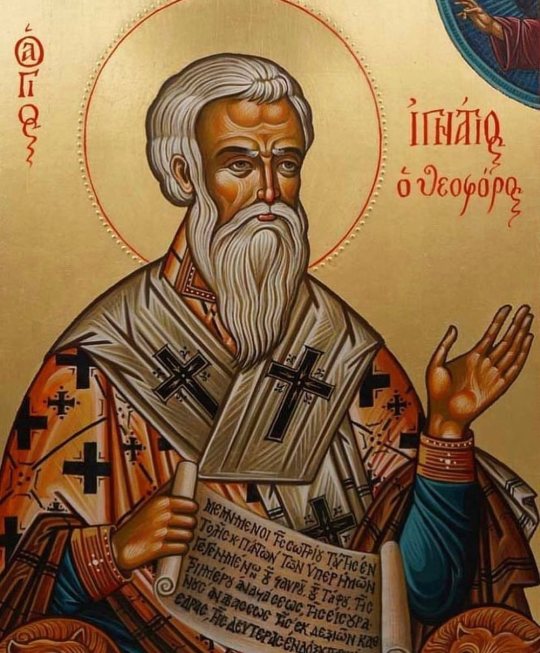
Today we celebrate the Hieromartyr Ignatius the God Bearer. According to tradition, Saint Ignatius was the child that Christ Himself held and said, "unless you turn and become as little children, you shall not enter into the Kingdom of Heaven”. As he grew up, Ignatius constantly dwelt on the things on high and thus earns himself the name "God-Bearer". Saint Ignatius was a fervent disciple of the Evangelist John the Theologian, with his fellow student Saint Polycarp of Smyrna. In time, he was elected Bishop of Antioch and spared no effort to build up the Church of Christ. The tradition of chanting antiphonally in church (i.e. in two choirs) was passed down to us from Saint Ignatius himself, who, in a vision, was transported to heaven and beheld the angles glorifying God in such a manner. During the persecution of the Emperor Trajan, Ignatius boldly confessed Christ as Trajan himself travelled through Antioch. Ignatius was arrested for not sacrificing to the idols and was condemned to death in Rome. The sentence was held in Rome because Trajan knew that if Ignatius were killed in Antioch, the Christians would venerate his relics. On his way to Rome, Ignatius fervently preached the Word of God and multitudes gathered to hear him. During this time, he wrote his many famous epistles to various people and churches, all of which survive today and are studied by theologians all around the world. Arriving in Rome, Saint Ignatius was sentenced to be thrown to the lions. When this occurred, the wild beasts tore the Martyr to shreds, leaving only his heart untouched. When the guards cut open his heart, they found the words "Jesus Christ" inscribed in gold writing. Hearing of the great courage of Ignatius, Trajan favoured him and ceased persecuting the Christians. May he intercede for us always + #saint #ignatius #ignatios #hieromartyr #martyrdom #godbearer #theophoros #martyrdom #christ #jesus #jesuschrist #christian #christianity #lions #antioch #bishop #jerusalem #rome #emperor #trajan #emperortrajan #polycarp #polycarpofsmyrna #smyrna #johntheevangelist #johnthetheologian #saintjohn #stjohn #john #orthodox #saintoftheday (at Antioch, Turkey) https://www.instagram.com/p/CmXabSMyGT5/?igshid=NGJjMDIxMWI=
#saint#ignatius#ignatios#hieromartyr#martyrdom#godbearer#theophoros#christ#jesus#jesuschrist#christian#christianity#lions#antioch#bishop#jerusalem#rome#emperor#trajan#emperortrajan#polycarp#polycarpofsmyrna#smyrna#johntheevangelist#johnthetheologian#saintjohn#stjohn#john#orthodox#saintoftheday
13 notes
·
View notes
Text


In rocky Herzegovina, not far from the city of Trebinje, there sits the Monastery of Sts. Peter and Paul. Church Tradition preserves testimony that the apostles Paul and Titus passed through the area and preached on their way to Dalmatia. In the mountains, not far from the monastery is St. Paul’s cave, where the apostle stayed. The churches of the monastery date back to ancient times, as evidenced by the architectural excavations and scholarly research conducted there.
The larger Basilica of the Apostle Peter was restored back in 1906 by the efforts of the hieromartyr Metropolitan Peter Zimonjic, who suffered from the Croatian Ustaše in 1941. The smaller church is dedicated to the apostle Paul. It was in a dilapidated state for centuries but was fully restored in 2007. In fact, it was built over the existing basilica, on a triconch1 plan. The remains of the ancient basilica and baptistery are carefully preserved within it. It is now an active church where the Divine Liturgy is again celebrated. In its original fresco iconography, the events of the apostolic age and the history of the Serbian Church are intertwined.
Photos and text by Hieromonk Ignaty (Shestakov), translated by Jesse Dominick / OrthoChristian.com
14 notes
·
View notes
Text
The Holy Hieromartyr Hypatius, Bishop of Gangra
Reading from the Synaxarion:
This Saint, who was from Cilicia of Asia Minor, became Bishop of Gangra, the capital of Paphlagonia. He was present at the First Ecumenical Council. Because of his confession of the Orthodox Faith, he was put to death by the Novatians, a sect which denied that sins committed after Baptism could be forgiven.
Apolytikion of Hieromartyr Hypatius in the First Tone
Thou didst prove to be a citizen of the desert, an angel in the flesh, and a wonderworker, O Hypatius, our God-bearing Father. By fasting, vigil, and prayer thou didst obtain heavenly gifts, and thou healest the sick and the souls of them that have recourse to thee with faith. Glory to Him that hath given thee strength. Glory to Him that hath crowned thee. Glory to Him that worketh healings for all through thee.
Kontakion of Hieromartyr Hypatius in the Third Tone
Celebrating blamelessly the sacred rites, O Hypatius, thou didst greatly multiply the talent that thou wast given; and when thou didst strive in contest, thou wast presented as a godly sacrifice and holy first-fruits unto Him that glorified thee with signs and wonders that tongue of man cannot tell.
0 notes
Text

Today Oct 9 our #Catholic Friends are also celebrating the the feast day of Saint #Andronicus (patron of #silversmiths)
( www.catholic.org/saints/saint.php?saint_id=1405 )
Today our #GreekOrthodox Friends are celebrating the Day of #DionysiustheAreopagite (patron of #Lawyers)
( www.oca.org/saints/lives/2020/10/03/102843-hieromartyr-dionysius-the-areopagite-bishop-of-athens )
0 notes
Text
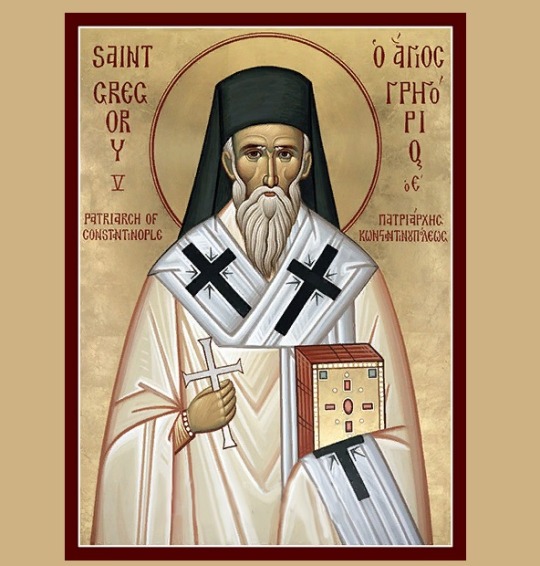
+++🙏🏻God Bless🕊️+++
Hieromartyr Gregory V (Angelopoulos), Patriarch of Constantinople
MEMORIAL DAY APRILL 23
Blessed are you, Christ our God, who gave power to the holy Patriarch and sent down His grace to him from above, in the same way He freed us from slavery to the enemy, Lover of mankind, glory to You.
💫International Orthodox Art Corporation Andcross
May the blessing of the Lord be upon you!
#orthodox church#orthodox icon#orthodox christmas#orthodoxia#jesus#iconofaday#orthodox christian#orthodox#russian orthodox#greek orthodox
3 notes
·
View notes